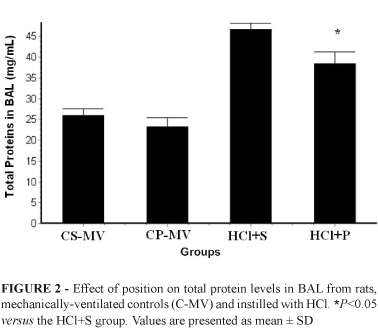PURPOSE: To compare the effectiveness of mechanical ventilation of supine versus prone position in hydrochloric acid (HCl)-induced lung dysfunction. METHODS: Twenty, adult, male, Wistar-EPM-1 rats were anesthetized and randomly grouped (n=5 animals per group) as follows: CS-MV (mechanical ventilation in supine position); CP-MV (mechanical ventilation in prone position); bilateral instillation of HCl and mechanical ventilation in supine position (HCl+S); and bilateral instillation of HCl and mechanical ventilation in prone position (HCl+P). All groups were ventilated for 180 minutes. The blood partial pressures of oxygen and carbon dioxide were measured in the time points 0 (zero; 10 minutes before lung injury for stabilization), and at the end of times acid injury, 60, 120 and 180 minutes of mechanical ventilation. At the end of experiment the animals were euthanized, and bronchoalveolar lavages (BALs) were taken to determine the contents of total proteins, inflammatory mediators, and lungs wet-to-dry ratios. RESULTS: In the HCl+P group the partial pressure of oxygen increased when compared with HCl+S (128.0±2.9 mmHg and 111.0±6.7 mmHg, respectively) within 60 minutes. TNF-α levels in BAL do not differ significantly in the HCl+P group (516.0±5.9 pg/mL), and the HCl+S (513.0±10.6 pg/mL). CONCLUSION: The use of prone position improved oxygenation, but did not reduce TNF-α in BAL upon lung dysfunction induced by HCl.
Lung; Respiration, Artificial; Oxygenation; Inflammation Mediators; Rats




